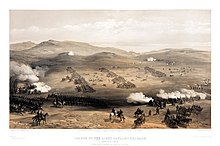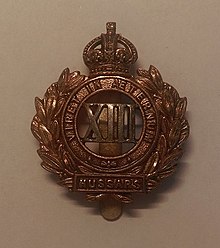|
13th Hussars
The 13th Hussars (previously the 13th Light Dragoons) was a cavalry regiment of the British Army established in 1715. It saw service for three centuries including the Napoleonic Wars, the Crimean War and the First World War but then amalgamated with the 18th Royal Hussars, to form the 13th/18th Royal Hussars in 1922. History Early warsThe regiment was raised in the Midlands by Richard Munden as Richard Munden’s Regiment of Dragoons in 1715 as part of the response to the Jacobite rebellion.[2] It took part in the Battle of Preston in November 1715 after which it escorted the rebels to the nearest prisons.[3] The regiment was sent to Ireland in 1718 and remained there until 1742.[4] During the 1745 Jacobite Rising, it was commanded by James Gardiner; largely composed of recruits, on 16 September the regiment was routed by a small party of Highlanders in the so-called 'Coltbridge Canter.'[5] Demoralised by this, it did the same at the Battle of Prestonpans on 21 September, which lasted 15 minutes and where Gardiner was killed and the equally disastrous Battle of Falkirk Muir in January 1746. Shortly after this, Gardiner's replacement Francis Ligonier died of sickness and was replaced by Philip Naison.[6] The regiment returned to Ireland in 1749[7] and was re-titled the 13th Regiment of Dragoons in 1751.[2] It was involved in putting down a minor rebellion by George Robert FitzGerald in 1781[8] and it converted to the light role in 1783.[2] A detachment from the regiment was sent to Jamaica in September 1795[9] and returned in July 1798.[10] Peninsular War In February 1810 the regiment sailed for Lisbon for service in the Peninsular War.[11] It took part in the Battle of Campo Maior on the Spanish-Portuguese border on 25 March 1811 in a clash that occurred between British and Portuguese cavalry, under Robert Ballard Long, and a force of French infantry and cavalry under General Latour-Maubourg. The regiment, two and a half squadrons strong, led by Colonel Michael Head, charged and routed a superior French cavalry force of no less than six squadrons.[12] The regiment, with two Portuguese squadrons, then went on to pursue the French for seven miles to the outskirts of Badajoz.[13] The report reaching Lord Wellington seems to have glossed over the epic quality of the charge and emphasised the overlong pursuit. After receiving Marshal Beresford's report, Wellington issued a particularly harsh reprimand to the regiment calling them "a rabble" and threatening to remove their horses from them and send the regiment to do duty at Lisbon. The officers of the regiment then wrote a collective letter to Wellington detailing the particulars of the action. Wellington is reported as saying that had he known the full facts he would never have issued the reprimand.[14] The historian Sir John Fortescue wrote, "Of the performance of Thirteenth, who did not exceed two hundred men, in defeating twice or thrice their numbers single-handed, it is difficult to speak too highly."[15] The regiment formed part of Beresford's Allied-Spanish Army at the Battle of Albuera on 16 May 1811.[16] The French army, commanded by Marshal Jean-de-Dieu Soult, Duc de Dalmatie, was attempting to relieve the French garrison of the border fortress of Badajoz. Only after bloody and fierce fighting, and the steadfastness of the British infantry, did the allies carry the day. The regiment, which was unbrigaded, formed part of the cavalry force commanded initially by Brigadier Robert Ballard Long and, later in the battle, by Major General Sir William Lumley.[17] The regiment also saw action at the Battle of Arroyo dos Molinos (October 1811),[18] under Rowland Hill at the Combat of Navas de Membrillo (December 1811),[19] at the Siege of Badajoz (March 1812)[20] and, as part of the 2nd Brigade under Colonel Colquohon Grant, at the Battle of Vitoria (June 1813).[21] The regiment advanced into France and fought at the Battle of the Nive (December 1813),[22] at the Battle of Orthez (February 1814)[23] and at the Battle of Toulouse (April 1814).[24] Waterloo The regiment, commanded by Lieutenant-Colonel Shapland Boyse and forming part of the 7th Cavalry Brigade, but operationally attached to the 5th Cavalry Brigade, next took part in the Battle of Waterloo in June 1815.[25][26] The regiment charged repeatedly during the day and completely routed a square of French infantry.[27] An officer of the 13th wrote:
At that battle the armies of Field Marshal the Duke of Wellington and Generalfeldmarschall Gebhard Leberecht von Blücher decisively defeated the armies of the Emperor Napoleon Bonaparte.[29] The Crimean War  The regiment next saw action, as part of the light brigade under the command of Major General the Earl of Cardigan, at the Battle of Alma in September 1854.[30] The regiment was in the first line of cavalry on the right flank during the Charge of the Light Brigade at the Battle of Balaclava in October 1854.[31] The brigade drove through the Russian artillery before smashing straight into the Russian cavalry and pushing them back; it was unable to consolidate its position, however, having insufficient forces and had to withdraw to its starting position, coming under further attack as it did so.[31] The regiment lost three officers and 38 men in the debacle.[31] Lance-Sergeant Joseph Malone of the E Troop was awarded the Victoria Cross for his actions during the battle.[32] The regiment also took part in the Battle of Inkerman in November 1854: the regiment played a minor role, although Captain Jenyns complained:
 The regiment went on to take part in the Siege of Sevastopol in winter 1854.[34] On 8 April 1861 the regiment was renamed the 13th Hussars[2] and in April 1862 the regiment started wearing hussar clothing.[35] The regiment departed for Canada in September 1866 as part of the response to the Fenian raids and sailed for India in January 1874.[35] Robert Baden-Powell, the future leader of the scouts, joined the regiment in India in 1876.[36] The regiment served in Afghanistan but saw no action during the Second Anglo-Afghan War.[35] The Second Boer War The regiment arrived in South Africa in December 1899 and took part in the Battle of Colenso during the Second Boer War.[37] It formed part of Colonel Burn-Murdoch's Brigade and had a minor part in the Relief of Ladysmith in February 1900.[37] The regiment stayed in South Africa throughout the hostilities, which ended with the Peace of Vereeniging on 31 May 1902. Following the end of the war, 556 officers and men of the regiment left South Africa on the SS City of Vienna, which arrived at Southampton in October 1902.[38] First World War The regiment, which was based in Meerut in India at the start of the war, landed in Marseille as part of the 7th (Meerut) Cavalry Brigade in the 2nd Indian Cavalry Division in December 1914 for action on the Western Front.[39] The regiment then moved to Mesopotamia, with the same brigade, in July 1916.[39] The regiment took part in the Second Battle of Kut in February 1917, the capture of Baghdad in March 1917 and the Battle of Sharqat in October 1918.[35] At Sharquat the regiment charged the hill where the Turkish guns were, and made a dismounted charge up it with fixed bayonets, successfully capturing the guns: İsmail Hakkı Bey, the Turkish commander, was aware of the peace talks at Mudros, and decided to spare his men rather than fight or break out, surrendering on 30 October 1918.[40] In 1922 the regiment amalgamated with the 18th Royal Hussars to form the 13th/18th Royal Hussars.[2] Regimental museumThe regimental collection is held by the Discovery Museum in Newcastle upon Tyne.[41] ColonelsThe colonels of the regiment were as follows:[2] 13th Regiment of Dragoons
A royal warrant provided that in future regiments would not be known by their colonels' names, but by their "number or rank" on 1 July 1751
From 1783 13th Regiment of Light Dragoons:
From 1861 13th Hussars:
In 1922 the regiment amalgamated with the 18th Royal Hussars to form the 13th/18th Royal Hussars Battle honoursThe regiment’s battle honours were as follows:[2]
See alsoReferences
Sources
External linksWikimedia Commons has media related to 13th Hussars.
|
||||||||||||||||||||||
